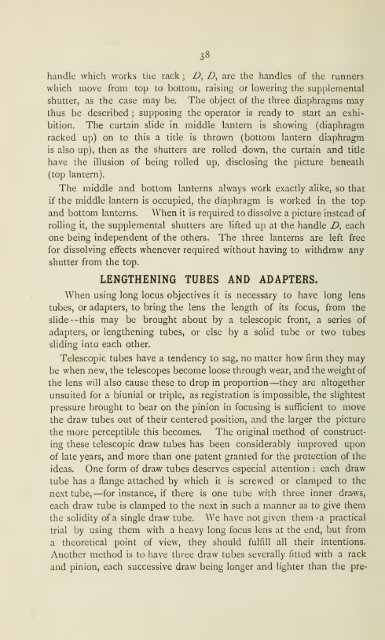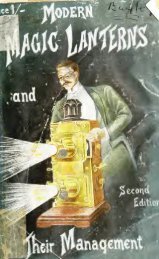The Art of projection and complete magic lantern ... - Yesterday Image
The Art of projection and complete magic lantern ... - Yesterday Image
The Art of projection and complete magic lantern ... - Yesterday Image
- No tags were found...
You also want an ePaper? Increase the reach of your titles
YUMPU automatically turns print PDFs into web optimized ePapers that Google loves.
38h<strong>and</strong>le which works the rack ; D, D, are the h<strong>and</strong>les <strong>of</strong> the runnerswhich move from top to bottom, raising or lowering the supplementalshutter, as the case may be. <strong>The</strong> object <strong>of</strong> the three diaphragms maythus be described ;supposing the operator is ready to start an exhibition.<strong>The</strong> curtain slide in middle <strong>lantern</strong> is showing (diaphragmracked up) on to this a title is thrown (bottom <strong>lantern</strong> diaphragmis also up), then as the shutters are rolled down, the curtain <strong>and</strong> titlehave the illusion <strong>of</strong> being rolled up, disclosing the picture beneath(top <strong>lantern</strong>).<strong>The</strong> middle <strong>and</strong> bottom <strong>lantern</strong>s always work exactly alike, so thatif the middle <strong>lantern</strong> is occupied, the diaphragm is worked in the top<strong>and</strong> bottom <strong>lantern</strong>s. When it is required to dissolve a picture instead <strong>of</strong>rolling it, the supplemental shutters are lifted up at the h<strong>and</strong>le Z>, eachone being independent <strong>of</strong> the others. <strong>The</strong> three <strong>lantern</strong>s are left freefor dissolving effects whenever required without having toshutter from the top.LENGTHENING TUBES AND ADAPTERS.withdraw anyWhen using long locus objectives it is necessary to have long lenstubes, or adapters, to bring the lens the length <strong>of</strong> its focus, from theslide — this may be brought about by a telescopic front, a series <strong>of</strong>adapters, or lengthening tubes, or else by a solid tube or two tubesshding into each other.Telescopic tubes have a tendency to sag, no matter how firm they maybe when new, the telescopes become loose through wear, <strong>and</strong> the weight <strong>of</strong>the lens will also cause these to drop in proportion—they areunsuited for a biunial or triple,altogetheras registration is impossible, the slightestpressure brought to bear on the pinion in focusing is sufficient to movethe draw tubes out <strong>of</strong> their centered position, <strong>and</strong> the larger the picturethe more perceptible this becomes. <strong>The</strong> original method <strong>of</strong> constructingthese telescopic draw tubes has been considerably improved upon<strong>of</strong> late years, <strong>and</strong> more than one patent granted for the protection <strong>of</strong> theideas. One form <strong>of</strong> droAv tubes deserves especial attention : eachdrawtube has a flange attached by which it is screwed or clamped to thenext tube,— for instance, if there is one tube with three inner draws,each draw tube is clamped to the next in such a manner as to give themthe solidity <strong>of</strong> a single draw tube. We have not given them -a practicaltrial by using them with a heavy long focus lens at the end, but froma theoretical point <strong>of</strong> view, they should fulfill all their intentions.Another method is to have three draw tubes severally fitted with a rack<strong>and</strong> pinion, each successive draw being longer <strong>and</strong> lighter than the pre-





